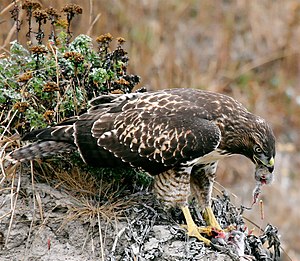Field Guide/Birds/Buteo jamaicensis
| Buteo jamaicensis (Red-tailed Hawk) | |
|---|---|
 |
|
| Description | |
| The Red-tailed Hawk (Buteo jamaicensis) breeds from western Alaska and northern Canada to Panama and the West Indies. Males are typically smaller than females, generally weighing between 800–1100 grams This is one of three species colloquially known in the United States as the "chickenhawk". It is the most common North American hawk and the raptor most frequently taken from the wild (and later returned to the wild) for falconry in the United States. Birds of this species have a dark mark along the leading edge of the underwing, between the body and the wrist. Most, but not all color variations have a dark band across the belly. In most, the adults' tails are rusty red above, and juveniles have narrow brown and pale bands. The main western North American population has bands on the adults' rusty tails as well and has varied plumage, organized into three main color types or morphs. Immature birds, or birds that are only a few years old, can also readily be identified by having yellowish irises. As the bird attains full maturity over the course of 3–4 years, the iris slowly darkens into a reddish-brown hue. The breeding habitat is open country with high perches. They build a stick nest in a large tree, in a cactus, or on a cliff ledge 35 m or higher above ground; they may also nest on man-made structures. Both sexes build the sturdy nest, made of different sized twigs and sticks, lined with fresh green foliage and evergreen sprigs. The fresh sprigs are regularly replaced during incubation. Up to four eggs may be laid at daily intervals. The shells are colored a dull or bluish-white with a granulated or smooth surface, never glossy. There may be some splotches of various shades of brown. Incubation is by the female from 28 to 35 days, during which time she is fed by the male. The young are able to fly at about 45 days. In most of the United States, Red-tailed Hawks are permanent residents, but northern breeding birds migrate south in winter. Throughout their range in the U.S., Red-tailed Hawks receive special legal protections under the Migratory Bird Treaty Act of 1918. They have a complex relationship with humans, capable of both controlling rodent and other mammalian pests, and on occasion taking valuable fowl (which has led to them being one of the species described as a Chickenhawk). Red-tailed Hawks prefer to wait on a high perch and swoop down on prey; they also patrol open areas in flight. They mainly eat small mammals, birds and reptiles. Their favorite prey varies with regional and seasonal availability but includes most types of rodents, rabbits, pheasant, grouse, quail, rattle snakes, copperheads, lizards, and, when near the water's edge, carp and catfish. Those that live in cities may prefer pigeons and starlings, both of which are plentiful in many urban areas. In flight, these hawks soar with wings in a slight dihedral, flapping as little as possible. They sometimes hover on beating wings and sometimes "kite", or remain stationary above the ground by soaring into the wind. When soaring or flapping their wings, they typically travel from 30 km/h to 65 km/h, but when diving may reach speeds as high as 195 km/h. The Red-tailed Hawk is common and widespread, partly because it has benefited from the historic settlement patterns across North America. The clearing of trees in the east of North America provided hunting areas, and the practice of sparing woodlots left nest sites. Conversely, the planting of trees in the west provided nest sites where there had been none. The construction of highways with treeless medians and shoulders and with utility poles alongside provided perfect habitat for perch-hunting, so Red-tailed Hawks are now a common sight along highways. A certain recording of the cry of the Red-tailed Hawk is probably one of the most often heard cinematic sound clichés. This high, fierce scream is often featured in the background of adventure movies to give a sense of wilderness to the scene. However, the cry is more commonly used for the Bald Eagle, whose own vocalizations are quite different. | |